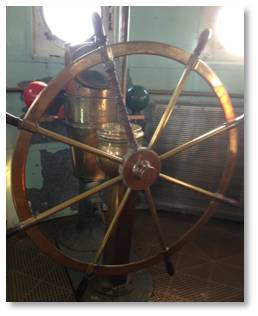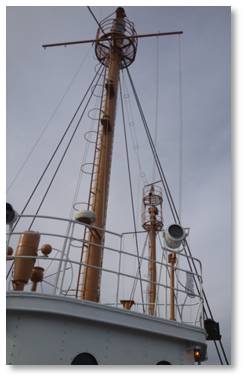On Saturday morning, I joined a small but hardy group of docents from Boston by Foot for a continuing education tour of the old Nantucket Lightship LV-112. A lightship is a floating lighthouse that warned ships away from reefs or shoals where building a permanent lighthouse was impractical or simply not feasible. They were administered and maintained by the U.S. Light House Service from 1819 until 1939 when the U.S. Coast Guard took over the service’s administration.
All lightships were named after the reefs or shoals they guarded and some had odd names like Handkerchief, Frying Pan or Stone Horse. Nantucket/LV-112, one of three vessels of the same name, was anchored on the Nantucket Shoal, which is 60 miles south of Nantucket Island and nearly 100 miles east of the mainland. It was the most remote lightship station in the service and the only one located in international waters.
History of Nantucket/LV-112
Nantucket Lightship LV-112 is of particular interest because its predecessor on the shoal, Nantucket/ LV-117, was rammed and sunk in heavy fog by RMS Olympic. Seven of its eleven crewmen died in the collision. The British government paid reparations for construction of this replacement vessel in 1936. It was designed to be unsinkable—with a double hull and multiple waterproof compartments. This is ironic because RMS Olympic was the sister ship of RMS Titanic—another “unsinkable” ship.
Nantucket/LV-112 guarded the shoal for 39 years and was known as the Statue of Liberty of the Sea because it was the first American landmark encountered by ships coming from Europe as they approached the United States. All transatlantic shipping set their course first to Nantucket Shoals Lightship Station before branching off to other east-coast destinations such as the Port of New York, which lay due west.
Touring the Ship
Saturday was a cold, raw day with a strong wind but we stayed aboard LV-112 for nearly two hours because the tour was so fascinating. Robert Mannino, Jr., president of the United States Lightship Museum, took us through the history, engineering, and construction of the ship. (He also gave us hot coffee and doughnuts, which were much appreciated.)
We heard what it was like to actually serve on one of these vessels from Dana Stetson, a former lightship sailor who served on the other Nantucket Lightship (LV-613). Nantucket/LV-613 was assigned to the Nantucket Shoals Lightship Station after LV-112 was decommissioned in 1975. It was the last lightship to serve there until the U.S. Lightship Service was discontinued in 1983.
I had always thought the lightships romantic but we heard first-hand that the experience of serving on one was anything but. They were at the bottom of every seaman’s list of preferred duty stations for reasons that quickly became obvious.
Life Aboard a Lightship
First, the lightships stayed on their stations in all weather, regardless of how bad. That meant the ship was always moving, up and down with the waves and sometimes from side to side with cross waves. We saw pictures of the Nantucket with her decks completely submerged by waves during Hurricane Carol (Category 3) in 1954.
Then there was the noise. During a storm the crewmen endured the bang of the anchor chain as it went slack and then slammed taut against the hull.It’s a big chain so it made a big noise. When the fog set in, the horn went off four times a minute and the fog bell added to the din. (We rang it—it’s loud!) There was the howl of the wind, the creak of the ship and the slap of waves on the hull. The crewmen added their own noise, of course, but they had to talk around periodic blasts from the fog horn—which gave them an odd way of speaking in short bursts. Seasickness was common.
Boredom was another factor because the crew stayed aboard for up to a year at a time. They had no cell phones, laptop computers, video games, or DVDs, or other modern ways of passing the time. Movies came aboard in reels when the ships were re-supplied and the crew watched them in the galley at night. Otherwise they spent their off-duty hours reading, playing cards, and—for part of the ship’s history—weaving baskets.
The Nantucket Lightship Basket
The widely famous Nantucket Lightship Basket originated here. They were woven by crewmen and officers aboard ship during the latter half of the nineteenth century. This activity ceased after 1900 and production moved to Nantucket Island.
I had a particular interest in the @BostonbyFoot tour and this particular ship because it was the origin of the distinctive Nantucket Lightship Basket. As a young woman my mother, then Marie Boisselle, worked for Ma Bell, which she always called “the phone company.” They sent her around to various places in New England to train young women how to work the switchboard and become dependable employees. She also taught them professional hygiene and work habits. Mom spent part of one summer training operators on Nantucket. When she left, “the girls” gave her a lightship basket that had been made on the island by master craftsman Jose Reyes. She used it to hold scraps of fabric and had no idea that these baskets had become valuable until we returned from an island vacation and told her that her “sewing basket” was not just an ordinary container.
When Mom passed on, her Lightship Basket came to me and I keep it in my office.
Preserving the Nantucket LV-112
Nantucket Lightship LV-112 is now a museum and learning center that is open to the general public on Saturdays from April through November.
It was rescued from neglect in 2008 and transported back to its home port of Boston. The preservation effort has been ongoing since then. The museum needs volunteers to help with the restoration as well as (tax-deductible) contributions for both restoration and maintenance. You can help by calling 617-797-0135 or emailing rmmjr2@comcast.net.





